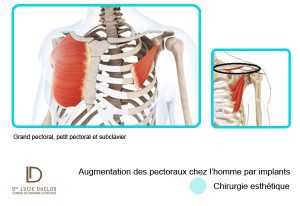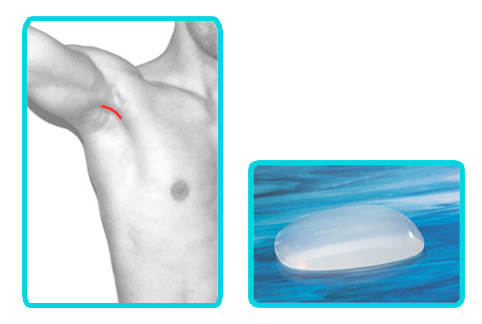Who can benefit from pectoral implants?
The installation of pectoral implants is mainly aimed at mature men whose chest has become sagging or at young men who do not obtain the results they desire with bodybuilding. The result of this operation, which must be carried out by a cosmetic surgeon, is the increase in the volume of the pectorals and is visible immediately after the procedure. The torso then presents natural-looking muscularity with well-defined pectorals: the implants blend into the silhouette while redefining it. The surgery is not very painful and leaves virtually no scars.
This act of cosmetic surgery can also be reconstructive, as in cases of breast malformations or anomalies such as asymmetry (difference in shape) between the two pectorals, hypotrophy (insufficient development) or aplasia (absence) of a pectoral muscle as for example in Poland syndrome.
The male torso
The pectoral region is made up of 3 muscles: the pectoralis major, the pectoralis minor and the subclavius. The pectoral major covers the other two and it is this which is outlined under the skin. Bodybuilding exercises aim to develop these large pectorals because they help give the torso its toned and masculine silhouette.
But the pectoral muscles do not always respond as we would like to bodybuilding, however regular or intensive it may be. It is all the more common in thin subjects. An accident or illness can also leave an individual with after-effects, for example preventing them from doing push-ups or lifting weights.

In these various cases, the placement of implants could prove to be the ideal solution: quick and painless, it allows the torso to be sculpted and harmonized in a natural and lasting way by increasing volume, projection and curve of the pectoral area.
Preoperative consultation
The preliminary consultation allows the client to ask any questions they wish about the surgery and anesthesia, possible risks or complications, contraindications or medications and postoperative recommendations from the practitioner.
This preliminary interview also allows him to express his wishes regarding the size and projection of the implant.
The healthcare professional, on the other hand, will suggest the prosthesis best suited to the size of his client’s pectoralis major and will advise him on the shape of the prosthesis: rather rectangular or rather oval.
A moderate projection and oval shape will create a natural contour; an accentuated projection and a rectangular shape will give a more athletic appearance.
Made from very resistant silicone, the implants are well tolerated by the body. However, we recommend changing them after ten years.
Are there any contraindications?
Contraindications are, among others: psychological disorders, chronic illnesses, coronary or respiratory problems. The preoperative medical evaluation carried out by the surgeon (examination, complete health check-up with blood tests, family history, etc.) allows the doctor to check that there are no contraindications to the operation and to rule out all risk.
Duration of the intervention
The procedure lasts approximately 1h30.
Anesthesia
The procedure is done under general anesthesia.
The intervention
The procedure consists of first making an incision of approximately 5 cm “sub-axillary”, that is to say under the arm, in a fold of the armpit.
The surgeon then inserts the silicone prosthesis in the “retro-pectoral” position, that is to say between the ribs and the pectoralis major muscle. The operation ends with the placement of absorbable stitches; no drain is necessary. Pain treatment and wearing a compression chest sleeve will be prescribed.

Operative consequences
The appearance of edema and bruising is completely normal in the first few days, as is discomfort when raising the arms; all of which could last a few weeks. The pain itself is well controlled by analgesics. The chest sleeve or compression bra must be worn for 2 to 4 weeks, night and day. A follow-up visit will be scheduled in the days following the procedure.
Daily activities can resume normally after 1 week, professional activity after 1 or 2 weeks; a gentle exercise such as walking can also be resumed without long delay, but you will have to wait 2 to 3 months before resuming more intense sports.
Pectoral prostheses can be worn for life or removed at the patient’s request.
Convincing results
The torso has a more muscular appearance without hindering muscular strength.
The scars are completely invisible because they are hidden in the fold of the armpit.
It takes between 4 and 6 weeks to be able to appreciate the final result.
The results are permanent and natural.
The client regains self-confidence and self-esteem.

What are the risks?
Risks include: risks commonly associated with anesthesia, movement of the prosthesis, general numbness, loss of sensation, bruising, accumulation of serous fluid (seroma) or infection.
Alternatives to implant placement
Other techniques allow the increase of the pectoral area in men, but they are not permanent.
Hyaluronic acid padding
The hyaluronic acid (HA) molecule is naturally present in the body. This will be injected above the pectoral muscle, into the deeper layers of the skin. For the pectorals, we use a more cross-linked (thicker) acid than the one injected into the lips. The effects are immediate but not permanent (around 1 year).
Lipofilling (or lipomodeling)
This technique consists of self-grafting fatty tissue from the patient in the part of his body that we wish to enlarge. It is sometimes combined with the placement of implants.

